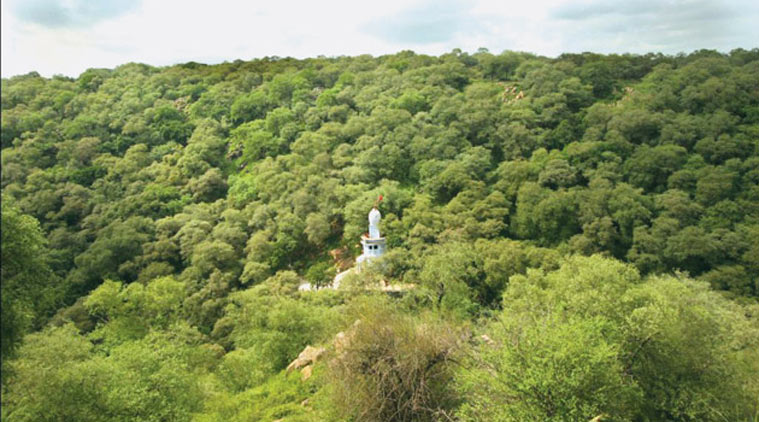INDIA’S FOREST COVER
INDIA’S FOREST COVER

CONTEXT
The recently released India State of Forest Report (ISFR) 2021 shows the total forest and tree cover in India is 80.9 million hectares, which is 24.62 per cent of the geographical area of the country. Between 2019 and 2021, the forest and tree cover rose by 2,261 sq km.
FOREST IN INDIA
Definition of forest cover is in sync with that of the Kyoto Protocol
“Forest”
- Has a minimum area of 0.05 to 1 ha (India has 1.0 ha minimum)
- Tree crown cover percentage being more than 10 to 30 per cent (India has 10 per cent)
- Trees having the potential to reach a minimum height of 2 to 5 m at maturity in situ (in India, it’s 2 m).
ON A WHOLE – “all lands, more than 1 hectare in area, with a tree canopy density of more than 10 per cent irrespective of ownership and legal status. Such lands may not necessarily be a recorded forest area. It also includes orchards, bamboo, palm etc.”
HOW IS THE ASSESMENT DONE
- Based on the interpretation of satellite data, which basically identifies umbrella-shaped canopies from the sky.
- All species that fulfil the above definition of forest cover are included in the assessment.
- The accuracy of classification for forest and non-forest is 95.79 per cent and the accuracy of classification in different density classes is as high as 92.99 per cent.
- Also estimated from field inventory data, which corroborates the figures of forest cover obtained from the satellite-based interpretation.
INSTITUTION ESTIMATING – Forest Survey of India
CONCERNS ABOUT RECENT REPORT
- Revising data from previous cycles
- Question raised is about plantations
WHAT WAS TOLD ABOUT THE CONCERNS
- The experience gained over the years is helpful in better interpretation in successive cycles. The improved quality of data, better interpretation, extensive ground-truthing and geographical area corrections result in revised estimates of previous cycles.
- The importance of plantations needs to be understood. For example, cashew plantations, which mainly grow along the coast, serve as the first line of defence against cyclones, which are hitting with greater frequency and ferocity. Mixed plantations, especially of native species, meet all the ecological functions of natural forests. A lot of wildlife inhabits these plantations. It is important to recognise their ecological functions.
WHAT IS INDIA DOING
- India is on track to achieve its national commitment to land degradation neutrality
- India is working towards restoring 26 million hectares of degraded land by 2030. This would contribute to India’s commitment to achieving an additional carbon sink of 2.5 to 3 billion tonnes of carbon dioxide equivalent.
- Afforestation efforts are also aligned with our wildlife conservation efforts.
- Project Tiger was launched in 1973. From nine tiger reserves initially, we now have 51 tiger reserves.
- Tiger habitat conservation will create a huge carbon sink in the form of tiger-bearing forests. Thus, the conservation of tigers will go a long way in ensuring a good future for us and the coming generations.
- Similar steps are being taken for the conservation of lions, elephants and other animals whose existence is threatened by poaching or the shrinking of natural habitat.
- Goal of 33 per cent area under forest and tree cover as per the National Forest Policy, 1988, remains to be achieved. In the present scenario, the possibility of a sizeable increase in forest cover is limited due to the inelasticity of forest land.
- The balance of 9 per cent can be achieved through taking up plantation/afforestation outside the forests and restocking/plantation in degraded and scrub forests.
- Trees outside forest (TOF) is one major area where our hope rests.
- According to the ISFR 2021, the TOF extent comprises 36.18 per cent of the total forest and tree cover of the country.
DRAFT NATIONAL FOREST POLICY 2021
Focused on the promotion of TOF by including it among its objectives.
Provisions include
- Substantially increasing the tree cover outside forests by incentivising and promoting agro-forestry and farm forestry
- Managing and expanding green spaces in urban and peri-urban areas to enhance citizens’ well-being
- Plantation of trees outside forests in partnership with local communities, land-owning agencies, and private enterprises
- Creation, sustainable management and promotion of urban forests (woodlands, gardens, avenue plantations, herbal gardens, etc.) as an integral component of urban habitat planning and development
- Afforestation/reforestation in public-private partnership (PPP) mode
- Promotion of urban forests, which include woodlands, wetlands, parks, tree groves, tree garden, plantations in institutional areas, on avenues and around water bodies, etc.
It is with this holistic approach that India is moving towards restoring the ecological balance of the planet and ensuring sustainable development.

